
The Buthidae are the largest family of scorpions, containing about 100 genera and 1339 species as of 2022. A few very large genera are known, but a high number of species-poor or monotypic ones also exist. New taxa are being described at a rate of several new species per year. They have a cosmopolitan distribution throughout tropical and subtropical environments worldwide. Together with four other families, the Buthidae make up the superfamily Buthoidea. The family was established by Carl Ludwig Koch in 1837.
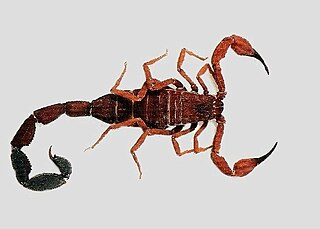
Tityus is a large genus of thick-tailed scorpions, the namesake of its subfamily Tityinae. As of 2021, Tityus contains more than 220 described species distributed in Central America and South America, from Costa Rica to Argentina. Species in the genus Tityus have been studied for hundreds of years, long before the taxonomic classification was put in place. Tityus tend to be of medium size for scorpions, roughly 50 to 70 millimeters long. They are dark brown or red in color, and can exhibit sexual dimorphism. They can live in a variety of environments, ranging from urban to arid mountains to the Amazon Rainforest. Tityus scorpions are best known for their venom and potent sting. The genus contains several dangerously venomous scorpions, the best known of which is the Brazilian yellow scorpion, T. serrulatus. Its venom can cause severe illness, and in the young, old and infirm even death. Some experts have argued that the genus as a whole may be paraphyletic, which could explain the knowledge gaps related to Tityus.

Androctonus maroccanus is a species of scorpion of the family Buthidae. Along with other members of the genus Androctonus it is also known by the collective vernacular name fat-tailed scorpion. A. maroccanus is endemic to the Atlantic coast of central Morocco.
Buthacus is a genus of scorpion of the family Buthidae. It is distributed across northern and western Africa, Israel, Palestine, Jordan, Syria, the Arabian Peninsula, Iraq, Iran, Afghanistan, and Pakistan.
The taxonomy of scorpions deals with the classification of this predatory arthropod into 13 extant families and about 1,400 described species and subspecies. In addition, 111 described taxa of extinct scorpions are known.
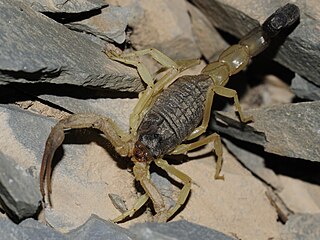
Hottentotta is a genus of scorpions of the family Buthidae. It is distributed widely across Africa, except for most of the Sahara desert. Species in the genus also occur in the Middle East, the Arabian Peninsula, southeastern Turkey, Iraq, Iran, Afghanistan, Pakistan, India, Nepal, Cape Verde Islands, and Sri Lanka (introduced).
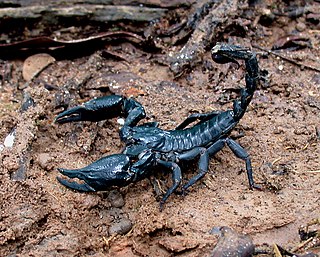
Heterometrus, whose members are also known by the collective vernacular name Asian Forest Scorpion, is a genus of scorpions belonging to the family Scorpionidae. It is distributed widely across tropical and subtropical southeastern Asia, including Indonesia, Brunei, Malaysia, Myanmar, Philippines, Singapore, Cambodia, Laos, Thailand, Vietnam, India, and China (Hainan). It is notable for containing some of the largest living species of scorpions.

Leiurus is a genus of scorpion of the family Buthidae. The most common species, L. quinquestriatus, is also known under the common name Deathstalker. It is distributed widely across North Africa and the Middle East, including the western and southern Arabian Peninsula and southeastern Turkey. At least one species occurs in West Africa.
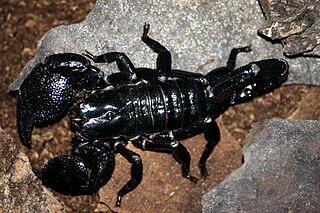
Pandinus is a genus of large scorpions belonging to the family Scorpionidae. It contains one of the most popular pet scorpions, the emperor scorpion . The genus is distributed across tropical Africa.
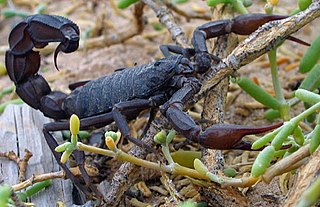
Androctonus crassicauda, the Arabian fat-tailed scorpion, is a species of extremely dangerous scorpion usually found in North Africa and the Middle East.

Androctonus bicolor, the black fat-tailed scorpion, is a scorpion species of the family Buthidae. It is black in color and can grow up to 8 cm. Black fat-tailed scorpions come from the family Buthidae, which is the largest of the scorpion family. They can be identified by their hefty physique. They tend to move very fast, and are of an aggressive nature. Black fat–tailed scorpions can live for up to 5 years. Adults can reach up to 40-60 millimeters, 80 millimeters being the maximum. These scorpions typically possess black and brown coloration. These scorpions enjoy making scrapes with wood and rocks, and are nocturnal, thus they hide in crevices or certain objects during the day. They stay in shade to retain moisture in their bodies, as they are susceptible to losing moisture due to their environmental preference.
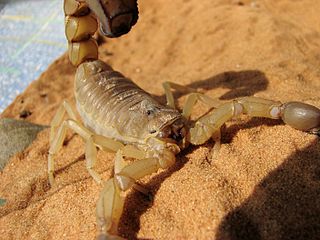
Androctonus australis, the yellow fat-tailed scorpion, is a hardy desert scorpion from North Africa, Somaliland, the Middle East, Pakistan and India.
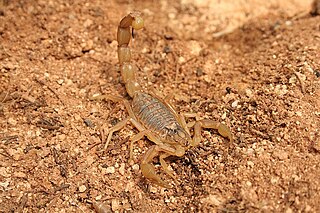
Buthus is a genus of scorpion belonging and being eponymous to the family Buthidae. It is distributed widely across northern Africa, including Morocco, Mauritania, Algeria, Tunisia, Libya, Egypt, Senegal, Guinea-Bissau, Nigeria, Sudan, Somalia, Ethiopia, Djibouti, as well as the Middle East, including Israel, Palestine, Jordan, Lebanon, Iraq, Yemen, and possibly Saudi Arabia and southern Turkey. Its European range includes the Iberian Peninsula, southern France, and Cyprus.
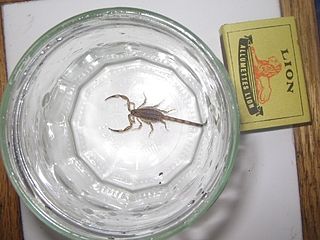
Isometrus is a genus of scorpion belonging and being eponymous to the family Buthidae. Some species are currently assigned to the genus Reddyanus.
Mesobuthus is an Asian genus of scorpions in the family Buthidae.

Leiurus abdullahbayrami is a species of scorpion in the family Buthidae. Its venom is highly toxic to humans, but can be used in medical development.
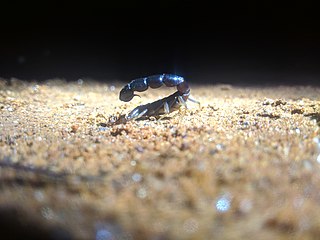
Buthoscorpio is a genus of scorpions in the family Buthidae.
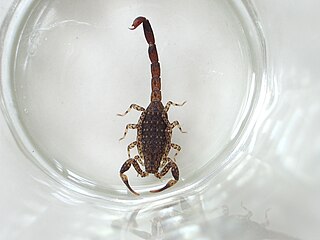
Lychas is a genus of scorpions belonging to the family Buthidae. It is one of the most widespread genus of the scorpions, where the species are found throughout in Africa and Seychelles, and in the Oriental region from India to Melanesia.

Charmus is a genus of buthid scorpions native to India and Sri Lanka.

Reddyanus is a genus of buthid scorpions native to Oriental region from India, Sri Lanka, China: Tibet, to Melanesia. The genus was previously described as a subgenus of Isometrus.



















